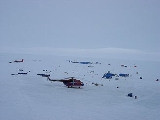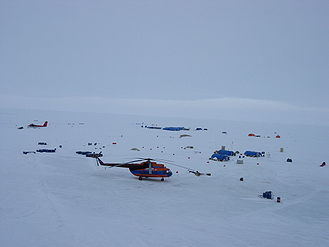
Barneo
Encyclopedia

Soviet and Russian manned drifting ice stations
Soviet and Russian manned drifting ice stations are important contributors to exploration of the Arctic. The stations are named North Pole Soviet and Russian manned drifting ice stations are important contributors to exploration of the Arctic. The stations are named North Pole Soviet and...
established by the Russian Academy of Sciences Arctic and Scientific Research Institute of the Arctic and Antarctic headquartered in St. Petersburg.
2011 will mark the establishment of the tenth sequential "Barneo" ice base.
Because of the constant moving ice on the Arctic Ocean
Arctic Ocean
The Arctic Ocean, located in the Northern Hemisphere and mostly in the Arctic north polar region, is the smallest and shallowest of the world's five major oceanic divisions...
, Barneo has to be rebuilt from scratch each year. Barneo is not merely a tent camp; a flown-in bulldozer was used to flatten the snow so cargo planes like the Antonov An-74 can land. Another runway is being built.
Barneo ice base is the unique complex consisting of ice runway and ice camp, both are integral parts of the project.
Ice runway
It is an airstrip of about 1200 by 60 meters size, which is built at the end of March on the drifting floe in the area around 89 degrees North. This is a fully functional runwayRunway
According to ICAO a runway is a "defined rectangular area on a land aerodrome prepared for the landing and take-off of aircraft." Runways may be a man-made surface or a natural surface .- Orientation and dimensions :Runways are named by a number between 01 and 36, which is generally one tenth...
, capable of landing the Antonov An-74 cargo-passenger aircraft
Aircraft
An aircraft is a vehicle that is able to fly by gaining support from the air, or, in general, the atmosphere of a planet. An aircraft counters the force of gravity by using either static lift or by using the dynamic lift of an airfoil, or in a few cases the downward thrust from jet engines.Although...
.
Ice Camp
Ice Camp is the main infrastructure component of dominantly tourist expeditions to the North PoleNorth Pole
The North Pole, also known as the Geographic North Pole or Terrestrial North Pole, is, subject to the caveats explained below, defined as the point in the northern hemisphere where the Earth's axis of rotation meets its surface...
, a unique complex for hosting visitors and base personnel. An Ice Camp consists of specially designed tents with rigid frames. All the tents are heated, and the temperature inside is kept between 15 and 18 °С.
The largest ones are mess tents: one for staff and one for visitors. These tents are connected by a kitchen block. Mess tent for visitors is the main place for meetings and briefings, here travelers meet and get to know each other. Breakfasts, lunches and dinners are served here at specified times, and snacks, tea or coffee are available 24 hours a day. Living tents for visitors accommodate up to 12 persons. Camp staff lives in separate modules. An important part of the Camp is cool bio-toilets. There are also technical modules for storing and maintenance of equipment.
If necessary, the Camp doctor can provide medical first aid.
The Scientific Camp and the camp of helicopter crews are satellites of the main Camp.
Since it is impossible to keep the runway on drifting ice floe for more than one season, the Camp has to be constructed from scratch every year; This is the main difference between this project and that of the similar projects in the Antarctic. At the end of every season all the equipment is removed from the ice.

